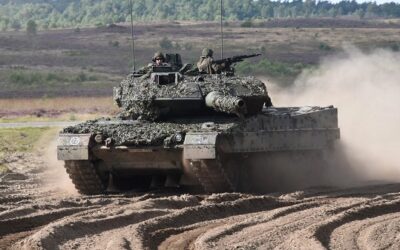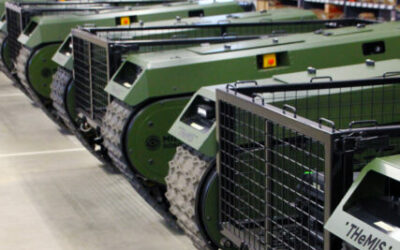Tangent Link’s EW GCC conference taking place in Abu Dhabi
Tangent Link’s Gulf Cooperation Council Electronic Warfare exhibition and conference (EW GCC – https://www.electronic-warfare-gcc.com/#/) will commence on 8 October, with a number of presentations and workshops which will examine the Anti-Access/Area Denial (A2AD) postures in the Middle East, and potential regional responses.
The proliferation of Anti-Ship Missiles (AShMs) into the region should be a cause for concern for strategists and navies alike. According to figures from the Stockholm International Peace Research Institute (SIPRI) arms control think tank between 2006 and 2017 284 AShMs were transferred by the People’s Republic of China (PRC) and Russia, to Iran and Syria. This is an average of almost 26 AShMs annually being delivered to these latter two countries. Worryingly, these weapons have proliferated to operational theatres around the region. For example, China Haiying Electromechanical Technology Academy C-802 series, locally designated as the Noor, Kosar and Sagheb, AShMs have been exported to Iran with the country receiving 50 missiles between 2006 and 2016. In addition, Iran may have exported 40 missiles to Syria. It is unclear whether these are drawn from the 50 missiles delivered from the PRC, or whether these were delivered directly from the former with the intention of Iran then exporting these to Syria. Beyond SIPRI’s figures, the Hezbollah insurgent organisation may have received five C-602s weapons between 2005 and 2006, and it is strongly suspected that these missiles were delivered to the organisation from Iranian stocks. The proliferation of the C-802 is a cause for concern as the weapon remains a potent threat to shipping. This was underscored on 9 October 2016 when the USS Mason ‘Arleigh Burke’ class destroyer came under attack from what was strongly suspected to have been a C-802 while underway in the Red Sea. The missile was thought to have been launched from an area of Yemen controlled by Houthi guerrillas. Iran has not confined its procurements of AShMs to the C-802. SIPRI’s information highlights that the country received China Aerospace Group C-704 AShMs, locally designated as the Nasr-1, between 2010 and 2011 receiving 50 such examples.
Similarly Syria has not confined itself to the procurement of the C-802. Evidence suggests that between 2009 and 2011 the country received 72 NPO Mashinostroyeniya P-800 (NATO reporting name SS-N-26 Strobile) and 87 Tactical Missiles Corporation Kh-31A (NATO reporting name AS-17 Krypton) AShMs from Russia although this latter procurement is thought to have included an undisclosed quantity of Kh-31P variant anti-radiation missiles. In February 2017 local media reports spoke of Hezbollah receiving P-800 missiles, presumably from the stocks originally supplied by Russia to Syria, based on information which was shared by Western intelligence sources during the 2017 Munich Security Conference; the world’s largest security policy event which takes place annually in the southern German city. A warehouse containing a number of the P-800 missiles was destroyed during an airstrike on a warehouse in Latakia, northwest Syria on 5 June 2013 where a number of these weapons were believed to be stored although US intelligence sources stated that several of these missiles were believed to have been moved before the attack. These may have been the weapons which have ended up in the hands of Hezbollah. That the Syrian government may have permitted their transfer would suit its strategic objectives: This would allow the Syrian government’s armed proxies to use these weapons against Syria’s enemies in the region, while at the same time affording Damascus a degree of strategic ‘distance’ between itself and actions against shipping in the Mediterranean involving these weapons.
Threat Envelope
These procurements should concentrate minds in the GCC. They represent both a potent asymmetric and A2AD threat to actors both within and without the region. These missiles possess ranges of between 19 nautical miles/nm (35 kilometres) for the C-704 up to 162nm (300km) for the P-800, depending on the variant. This allows maritime targets in both coastal areas and the littoral to be placed at risk. This would be a concern during the conduct of the enforcement of sanctions against a particular nation on the high seas, or during the conduct of an amphibious operation; thus potentially limiting the freedom of action of GCC navies, and their allies, in peacetime and during hostilities. AShMs’ potential as an asymmetric weapon for non-state actors was clearly underlined by the attack on the USS Mason discussed above. Even should such an attack fail, the very fact that an insurgent organisation could use AShMs against the surface combatants of GCC and allied nations, shows their potential to force navies into a defensive posture in the Red Sea, Persian Gulf and Mediterranean. Furthermore, a successful attack even against one naval vessel, risks handing the insurgents a significant propaganda victory, even if the damage it inflicts is minimal. Such a success could in turn stimulate the group’s demands for more AShMs from nations within and beyond the region whom maybe more than happy to supply them, whether out of ideological sympathy, or for simple financial gain.
AShMs can be relatively inexpensive to procure yet have an effect vastly outweighing the investment. Sources familiar with such weapons told the author that some PRC and Russian examples can have a ‘street value’ of circa $500,000 making them affordable for an insurgent organisation and cash-strapped state alike. Theoretically, A2AD is not so much focused on directly turning an intervention by against country ‘A’ by country “B’ to ‘A’s advantage, but instead achieving such an operational and strategic aim indirectly by inflicting enough materiel damage to country ‘B’s platforms and personnel that it falls under internal and external pressure to desist its intervention in the face of rising costs.
Protection
What efforts can regional actors make to lessen the threat from AShMs? At the operational level good reconnaissance and intelligence sharing can help allied nations to understand the extent of the threat they face, and where these threats come from. During any future conflict, it would be imperative to ensure that such weapons, and their supply lines become operational priorities for attack at an early stage. Tactically, GCC navies must ensure that their vessels are adequately protected against the AShM threat. This requires efficient hard and soft kill capabilities in the form of vessel-mounted Close-In Weapons Systems (CIWS) and surface-to-air missiles to engage AShMs, and decoys to incoming missiles. Underpinning these soft kill capabilities are vessels’ Electronic Support Measures (ESMs) can detect tell-tale emissions from an AShM’s radar seeker to warn the crew to take the necessary action to avoid their vessel being hit. As well as helping to protect a vessel, an ESM represents a useful means by which Electronic Intelligence (ELINT) can be gathered vis-à-vis the signal characteristics of an AShM’s Active Radar Homing (ARH) seeker allowing other ESMs; hard and soft kill systems; and vessel manoeuvring tactics to be updated to ensure that future attacks by a particular AShM can be effectively countered.
The Electronic Warfare (EW) and soft kill elements of anti-AShM tactics have to reckon with the RF (Radio Frequency) capabilities of modern AShMs. Broadly speaking, ARH seekers equipping such weapons typically transmit in X-band (8.5 gigahertz/GHz to 10.68GHz) and Ka-band (33.4GHz to 36GHz). In the future, AShM ARH seekers may migrate further into the so-called ‘millimetre wave’ portion of the electromagnetic spectrum; typically frequencies of 30GHz and above. Such ARH seekers can see a target in great detail. This improves the missile’s ability to detect and reject the decoys which a ship may launch such as chaff or corner reflectors. Nonetheless, the good news is that naval decoy manufacturers are highly aware of these threats and are ploughing their energies into corner reflector technology which can spoof them, while ESM manufacturers are taking a similar approach. Most naval ESMs already cover the two gigahertz to 18GHz waveband, comfortably encompassing X-band and Ka-band ARH seekers, with some products extendable to 40GHz allowing them to take future ARH seeker technological developments into account as sensors move into higher bandwidths. While decoy and jammer manufacturers are understandably coy about revealing the exact frequencies at which their products are effective, the author has been told by several senior figures involved in the commercial aspects of these domains that their products can comfortably address ARH seeker threats in millimetre wavebands.
Future Proofing
For the time being, provided the investment in the upkeep of existing vessel soft kill systems in the GCC continues, there should be few reasons why existing regional naval ESM, jammer and decoy capabilities should not be able to address the current AShM threat. Fortunately, several weapons profiled in this article are considered ‘legacy’ systems, having entered service between 1998 and 2006. That said, new AShMs are under development in Russia and China, and the potential proliferation of such weapons into the region should be a cause for concern. For example, the PRC’s new YJ-18 family of AShMs can reach speeds of up to 2000 knots (3,704 km/h) in the terminal phase with an estimated range of up to 290nm (540km), according to US Department of Defence estimates. Likewise Russia’s new NPO Mashinostroyeniya 3M22 Zircon (NATO reporting name SS-N-33) AShM is reportedly capable of achieving ranges of 620nm (1,000km) and speeds of 5,291 knots (9,800km/h). The missile is alleged to be equipped with a ‘cloaking device’ which is able to surround the missile with a cloud of ionised gas while inflight with the intention of absorbing radar transmissions to reduce the weapon’s radar cross section; a process dubbed ‘plasma stealth’, however sources in the intelligence community have shared with the author that these claims are to be treated with a degree of caution. That being said, plasma cloud or not, this weapon should still be treated with respect, and GCC navies would be highly advised to expect its appearance in the region, most likely on-board Russian warships in the near future.
The imperative for the navies of the GCC is that their combatants are outfitted with capable naval ESMs, decoy launchers and/or jammers which can be brought to bear against the regional AShM threat, particularly during both low and high intensity naval operations. At the operational level it is vital that navies share intelligence regarding the state and non-state AShM threat they face. While the sharing of ELINT is understandably highly sensitive, this should not preclude the sharing of less sensitive intelligence to ensure that GCC navies, and allied maritime forces comprehend the threat, and that they can take necessary self-protection actions. This will help to not only ensure the safety of vessels, it will ensure that they can continue to fight even when the AShM threat may be very pronounced, thus helping to defeat regional A2AD strategies of which AShMs remain an integral part.
@CAP: Russia’s 3M22 Zircon missile is a potential threat to GCC and allied navies, particularly when deployed on Russian warships operating in the region.
























